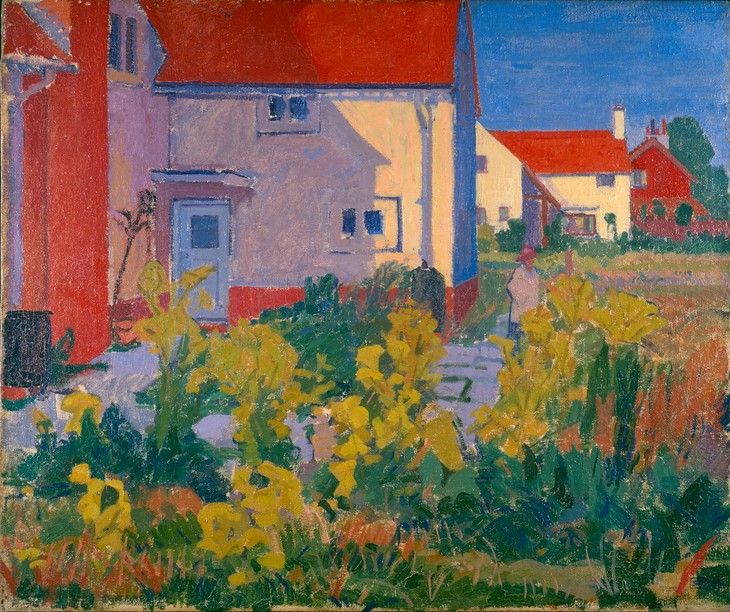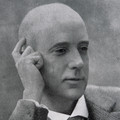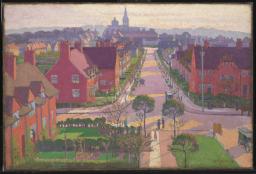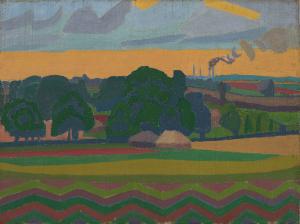Spencer Gore Letchworth 1912
Spencer Gore,
Letchworth
1912
This painting is thought to depict Norton Common in Letchworth Garden City. Although observed from nature, the simplified forms and bold colours suggest the influence of fauvism and cubism. Gore was then living temporarily in Letchworth and while there moved away from his earlier impressionist style.
Spencer Gore 1878–1914
Letchworth
1912
Oil paint on canvas
510 x 610 mm
Inscribed studio stamp ‘S.F. GORE’ bottom right
Purchased (Clarke Fund) 1933
N04675
1912
Oil paint on canvas
510 x 610 mm
Inscribed studio stamp ‘S.F. GORE’ bottom right
Purchased (Clarke Fund) 1933
N04675
Ownership history
Mrs Mary Johanna Gore, the artist’s widow; probably bought at Paterson and Carfax Gallery, London, in 1920 by J.W. Freshfield, who owned it by 1928; probably bought from him by Arthur Tooth and Sons, London, with whom by 1933 when bought by Tate Gallery for £55.
Exhibition history
1912
?The Camden Town Group, Carfax Gallery, London, December 1912 (13, as ‘Letchworth Common’).
1920
Paintings by the Late Spencer F. Gore, Paterson and Carfax Gallery, London, October 1920 (22, as ‘Near Letchworth’).
1928
Exhibition of Paintings by Spencer F. Gore, Leicester Galleries, London, April 1928 (68).
2006
Spencer Gore in Letchworth, Letchworth Museum and Art Gallery, September–October 2006 (7, reproduced).
References
1964
Mary Chamot, Dennis Farr and Martin Butlin, Tate Gallery Catalogues: The Modern British Paintings, Drawings and Sculpture, vol.1, London 1964, p.246.
1979
Wendy Baron, The Camden Town Group, London 1979, pp.48, 314, 374.
1980
Simon Watney, English Post-Impressionism, London 1980, reproduced fig.124.
1986
Pat Adams (ed.), With a Poet’s Eye: A Tate Gallery Anthology, London 1986, reproduced p.85.
2000
Wendy Baron, Perfect Moderns: A History of the Camden Town Group, Aldershot and Vermont 2000, pp.54, 178, 181.
Technique and condition
Letchworth is painted in artists’ oil paints on primed stretched canvas. The cloth is a mixture of flax (linen) and hemp threads and has a plain open weave with many slubs and other material trapped in the weave. The mark of the artists’ colourman Percy Smith is stamped on the back of the cloth. The canvas is attached to a four-member stretcher with steel tacks, in their original positions. Sizing is visible in the interstices of the weave at the back of the canvas and forms a minimal layer. White primer is also visible at the back filling the open weave. It is evenly applied covering the extant of the canvas and retaining the weave texture. The priming is composed of two distinct layers: a thin dense layer of lead white with chalk or gypsum, kaolin and zinc white over a thicker more transparent layer of chalk, zinc white or zinc sulphide, kaolin and probably silica extender. Gore seems to have experimented with alternatives to pure lead-based primers in the upper layer, initially reducing the proportion of lead white and adding other materials, including zinc white, and later replacing lead white altogether (see also Tate T01960). It gave him a preparatory surface that was slightly absorbent and retained the rough canvas weave texture. Lead-based primers were also thought to darken over time. Artists had begun to explore alternatives to lead white, such as zinc white, in the late nineteenth century reflecting a growing interest in the whiteness of the preparatory surface dating back to the Pre-Raphaelites in England and the impressionists in France.
The painting is vigorously executed in well-bound oil colours applied to a design freely drawn in dark blue paint (see also Tate T02260). There is no evidence of squaring-up or any other method for transfer from a drawing. The paint is brushed in broken sweeps of colours, contrasting the blue greens and greys of the foliage in shadow with accents of rustic pinks and browns provided by the broken fence, earth and tree trunks. The more acid greens are enlivened with a few strokes of orange. The blue drawing is restated in several areas during painting with rapid strokes that leave a fluid but broken line. In many areas the white ground is left visible through the broken application of the colour. In others, such as the trees on the far side of the field, a sense of distance is created by working the fluid, misty tones wet-in-wet without drawing to delineate the forms. The accent on colour is maintained by the limited tonal variation of mid-tones and tints while avoiding stark contrasts approaching black and white. The painting is unvarnished.
Roy Perry
April 2004
How to cite
Roy Perry, 'Technique and Condition', April 2004, in Robert Upstone, ‘Letchworth 1912 by Spencer Gore’, catalogue entry, May 2009, in Helena Bonett, Ysanne Holt, Jennifer Mundy (eds.), The Camden Town Group in Context, Tate Research Publication, May 2012, https://wwwEntry

Spencer Gore 1878–1914
Harold Gilman's House at Letchworth 1912
Oil paint on canvas
635 x 760 mm
Leicester Arts and Museums Service
Photo © Leicester Arts and Museums Service
Fig.1
Spencer Gore
Harold Gilman's House at Letchworth 1912
Leicester Arts and Museums Service
Photo © Leicester Arts and Museums Service
The large quantity of work that Gore produced in Letchworth marked an important point in his evolution as an artist. He began to move away from the impressionist style which characterised his Mornington Crescent period pictures into a way of working that was more resolutely modern. The stylisation and simplification of forms and use of pure colour suggest the partial influence of cubism and fauvism. Gore’s Letchworth paintings display a new dedication to geometric planes and pattern making, as well as the use of a staunchly anti-realist, bright and frequently almost lurid palette.
While the exact location shown in Letchworth is difficult to establish with complete certainty, it seems in all likelihood that it is a spot on Norton Common, the area of wooded and common land lying immediately to the north of the town. This was just a short distance from where Gore was staying at Wilbury Road. In the middle distance there is a small bridge over a stream which, if this is Norton Common, would be Pix Brook. The columns visible in the background may be connected with the bowling green on the common. Further evidence to support this location was given by Brynhild Parker, daughter of Stanley Parker. The Parkers lived next door to Gilman at 102 Wilbury Road. In 1982 Brynhild Parker wrote to Letchworth Museum and Art Gallery recalling Gore and that ‘He painted a picture of the Common near us, which is in the Tate’.1 No other picture except for Letchworth would fit this.
Robert Upstone
May 2009
Notes
Related biographies
Related essays
Related catalogue entries
How to cite
Robert Upstone, ‘Letchworth 1912 by Spencer Gore’, catalogue entry, May 2009, in Helena Bonett, Ysanne Holt, Jennifer Mundy (eds.), The Camden Town Group in Context, Tate Research Publication, May 2012, https://www






